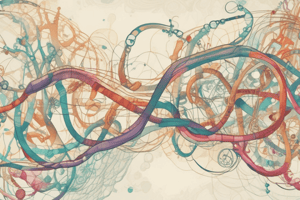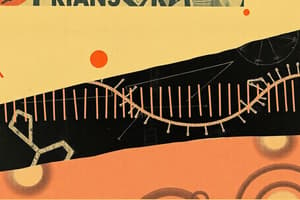Podcast
Questions and Answers
What is the first step a cell takes in reading out its genetic instructions?
What is the first step a cell takes in reading out its genetic instructions?
To copy a particular portion of its DNA nucleotide sequence-a gene-into an RNA nucleotide sequence.
What is the name given to the process of copying DNA into RNA?
What is the name given to the process of copying DNA into RNA?
Transcription.
The information in RNA is written in a different language than DNA.
The information in RNA is written in a different language than DNA.
False (B)
Transcription produces RNA that is identical to the DNA strand it is copied from.
Transcription produces RNA that is identical to the DNA strand it is copied from.
What is the name of the enzyme that performs transcription?
What is the name of the enzyme that performs transcription?
RNA polymerase requires a primer to initiate transcription.
RNA polymerase requires a primer to initiate transcription.
Which of the following statements is NOT true about RNA polymerase?
Which of the following statements is NOT true about RNA polymerase?
The RNA strand produced during transcription remains bound to the DNA template strand.
The RNA strand produced during transcription remains bound to the DNA template strand.
What is the term for a transcribed segment of DNA?
What is the term for a transcribed segment of DNA?
What is the main difference between transcription in bacteria and eukaryotes?
What is the main difference between transcription in bacteria and eukaryotes?
What is the name of the detachable subunit of bacterial RNA polymerase that helps it recognize the start site for transcription?
What is the name of the detachable subunit of bacterial RNA polymerase that helps it recognize the start site for transcription?
RNA polymerase binds very tightly to the promoter DNA before initiating transcription.
RNA polymerase binds very tightly to the promoter DNA before initiating transcription.
What is the name of the DNA sequence that signals the end of transcription?
What is the name of the DNA sequence that signals the end of transcription?
Transcription termination involves a reversible structural change in the RNA polymerase.
Transcription termination involves a reversible structural change in the RNA polymerase.
What is the main purpose of promoter sequences in DNA?
What is the main purpose of promoter sequences in DNA?
Promoter sequences are symmetrical.
Promoter sequences are symmetrical.
What is the main consequence of the asymmetry of promoter sequences?
What is the main consequence of the asymmetry of promoter sequences?
The choice of template strand for transcription is determined by the location of the promoter.
The choice of template strand for transcription is determined by the location of the promoter.
Flashcards
Transcription
Transcription
The process of making RNA from DNA, a crucial first step in gene expression.
RNA (Ribonucleic Acid)
RNA (Ribonucleic Acid)
The molecule transcribed from DNA, carrying genetic information to be translated into a protein.
Gene
Gene
A segment of DNA that contains the genetic instructions for building a specific protein, serving as the template for transcription.
Promoter
Promoter
Signup and view all the flashcards
Terminator
Terminator
Signup and view all the flashcards
RNA Polymerase
RNA Polymerase
Signup and view all the flashcards
Sigma (σ) Factor
Sigma (σ) Factor
Signup and view all the flashcards
DNA Unwinding
DNA Unwinding
Signup and view all the flashcards
RNA Chain Elongation
RNA Chain Elongation
Signup and view all the flashcards
Hairpin Structure
Hairpin Structure
Signup and view all the flashcards
Transcript
Transcript
Signup and view all the flashcards
mRNA (Messenger RNA)
mRNA (Messenger RNA)
Signup and view all the flashcards
rRNA (Ribosomal RNA)
rRNA (Ribosomal RNA)
Signup and view all the flashcards
tRNA (Transfer RNA)
tRNA (Transfer RNA)
Signup and view all the flashcards
Translation
Translation
Signup and view all the flashcards
Genome
Genome
Signup and view all the flashcards
DNA Replication
DNA Replication
Signup and view all the flashcards
Origin of Replication
Origin of Replication
Signup and view all the flashcards
DNA Polymerase
DNA Polymerase
Signup and view all the flashcards
Primer
Primer
Signup and view all the flashcards
Transcription
Transcription
Signup and view all the flashcards
Translation
Translation
Signup and view all the flashcards
Transcription Factor
Transcription Factor
Signup and view all the flashcards
Operon
Operon
Signup and view all the flashcards
Translation
Translation
Signup and view all the flashcards
Codon
Codon
Signup and view all the flashcards
Alternative Splicing
Alternative Splicing
Signup and view all the flashcards
Regulatory Sequence
Regulatory Sequence
Signup and view all the flashcards
Study Notes
Transcription: From DNA to RNA
- Transcription is the first step in a cell reading genetic instructions
- A portion of DNA (a gene) is copied into RNA
- The copied information in RNA uses the same language as DNA (nucleotides)
- The process copies a specific portion of a DNA nucleotide sequence known as a gene
- RNA carries the information to synthesize proteins
Transcription Produces RNA Complementary to One Strand of DNA
- RNA synthesis is similar to DNA replication (unwinding of a portion of DNA double helix)
- The process exposes bases on each DNA strand, then one strand of DNA serves as a template for RNA synthesis
- The RNA produced is complementary to the DNA template strand
- RNA is shorter than DNA
- The RNA polymerase, an enzyme, catalyzes the bonding of nucleotides in RNA
- RNA polymerase moves along the DNA, separating the DNA strands
- It adds new RNA nucleotides to the growing RNA chain (synthesis in 5' to 3' direction).
- RNA strand does not remain hydrogen-bonded to DNA template strand
- RNA is released as a single strand
Differences Between DNA and RNA Polymerases
- RNA polymerase doesn't require a primer to start RNA synthesis
- RNA polymerase is less accurate than DNA polymerase (about one mistake for every 10,000 nucleotides compared to 10 million for DNA).
- RNA polymerase has a modest proofreading mechanism
- RNA polymerase links ribonucleotides (not deoxyribonucleotides)
Cells Produce Several Types of RNA
- Different types of RNA are produced for various functions (messenger RNA, ribosomal RNA, transfer RNA, small nuclear RNA, small nucleolar RNA, microRNA, other noncoding RNAs)
- Each transcribed segment of DNA is a transcription unit
- In eukaryotes, a transcription unit typically carries the information for a single gene
- In bacteria, a set of adjacent genes can be transcribed as a unit
Signals Encoded in DNA
- RNA polymerase must recognize start and stop points in the DNA sequence to transcribe a gene accurately
- The way RNA polymerase performs varies between bacteria and eukaryotes.
Steps of Transcription in Bacteria
- RNA polymerase binds tightly to a specific sequence in the DNA called a promoter
- The polymerase opens the DNA helix to expose a short stretch of nucleotides
- It utilizes one of the two exposed DNA strands as a template
- The polymerase adds incoming ribonucleotides, constructing an RNA chain in the 5' to 3' direction
- The σ factor in the RNA polymerase dissociates as RNA synthesis continues
- The polymerase encounters a termination signal
- At the termination signal, the RNA strand detaches from DNA; RNA polymerase releases the DNA template.
Promoter Sequences
- Promoter sequences are asymmetrical in DNA
- They determine which DNA strand is used as a template for RNA synthesis
- The polymerase can only bind in one orientation in a specific location
- The direction of transcription is determined by the promoter location, and it proceeds in the 5'→3' direction.
Studying That Suits You
Use AI to generate personalized quizzes and flashcards to suit your learning preferences.




